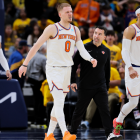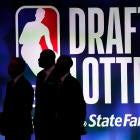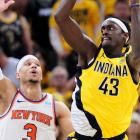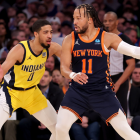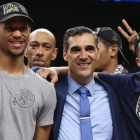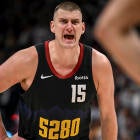Two-way players have never had more value in the NBA than they do right now. As we saw time and again in the 2018 NBA playoffs, contributing on offense and being capable of providing versatility on defense to guard multiple positions are invaluable assets for players hoping to maintain major minutes production in the league as it's currently constituted.
On defense, teams now consistently deploy a switch-everything approach. Rather than fighting through screens to keep pace with your man as the subject of a pick-and-roll, defenders are being asked to switch off onto the screener more often than not. This can create problems defensively, not the least of which being that smaller defenders are often targeted by bigger players. It's a tactic teams use to generate mismatches to create an advantage on offense -- one that we saw on numerous occasions in the NBA Finals.
Take the below play for instance that was run by the Cleveland Cavaliers in Game 1 of the Finals in crunch time. With under one minute to play, J.R. Smith sets a screen for LeBron James at the top of the key that forces Stephen Curry to switch off onto LeBron. LeBron's original defender on the play, Kevin Durant, is forced to switch onto Smith in the action. The result is an easy straight-line drive to the basket for James, who simply overpowers Curry with his strength to get a basket while drawing a foul.
Curry is not a wing, to be clear, nor does he fit the description of a 3-and-D category teams crave. This is merely an example of how NBA teams target weaker defenders on offense, and specifically on the perimeter. It's why versatility on defense and being able to switch onto players with greater size or strength is becoming an increasingly more valuable skillset, and the reason franchises are constantly on the lookout for prospects who can defend more than one position and can knock down open shots. It's the 3-and-D phenomenon that is overtaking the league.
Take this separate play with wing player (the most common 3-and-D prototype) Jaylen Brown of the Celtics, for instance. In Game 1 of the Eastern Conference Finals, the Cavaliers call Kyle Korver to screen for Kevin Love on the wing, which forces Love's defender, Aron Baynes, onto Korver. They achieve the result they want by forcing Korver's defender, Jaylen Brown, onto Love in hopes that Love can use his height advantage of three inches to post up and get an easy basket near the paint. The action ultimately backfires for Cleveland as Brown not only holds his own, but rejects Love's shot into the bench.
For NBA teams hoping to mitigate the risk of facing mismatches and seeing their weak-link defenders targeted possession after possession, franchises will be coveting the 3-and-D archetype -- whether it be a prospective big like Jaren Jackson Jr., or a true wing like Mikal Bridges -- in the 2018 NBA Draft. So as the countdown to draft night nears, let's grade the biggest names to watch and determine the strengths and weaknesses of those specific prospects by ranking their talents both as a 3-point shooter and as a defender, 1-10, to differentiate between them.
As a qualifier, this isn't necessarily the order I expect each name to come off the board. This is merely a power ranking of the 10 best 3-and-D prospects.
1. Jaren Jackson Jr. | Michigan State | Fr | PF
- 3-point grade: 8
- Defense grade: 10
Jaren Jackson Jr. is the rare big man with 3-and-D promise. At 6-foot-11, he shot an impressive 39.6 percent from the 3-point line as a freshman at Michigan State. But unquestionably his biggest upside is as a versatile defender who can guard nearly every position on the floor. He averaged 3.0 blocks and 0.6 steals per game in college, and projects to be a floor-spacing, rim-protecting big likely to hear his name called inside the top half of the lottery on Thursday.
2. Mikal Bridges | Villanova | Jr | SF
- 3-point grade: 9
- Defense grade: 9
Mikal Bridges proved he could do a little of everything at Villanova. He shot 43.5 percent from the 3-point line last season, and defined versatility on defense for the title-winning Wildcats by drawing some of the toughest assignments on a nightly basis. He's the most ready-made contributor on this list.
3. Khyri Thomas | Creighton | Jr | SG
- 3-point grade: 9
- Defense grade: 9
A two-time Big East Defensive Player of the Year winner, Creighton guard Khyri Thomas has a game crafted for the NBA as a 3-and-D utility player. He shot 41.1 percent from the 3-point line last season and offers up intensity on defense as a perimeter player that is unrivaled. His 6-10.5 wingspan is a major plus to his 6-4 frame.
4. Josh Okogie | Georgia Tech | So | SG
- 3-point grade: 8
- Defense grade: 9
Okogie's upside is off the charts. At Georgia Tech, he was a high-flying guard who operated as the No. 1 option on offense. He was also the Yellow Jackets' most versatile defender. Okogie moves well without the ball and has a high enough basketball IQ to be a difference-maker with or without the ball. If he can tighten up his shooting off the dribble and improve his ability to distribute the ball, he has Donovan Mitchell-like potential. On defense, he has a mix of shot-blocking and takeaway ability to be an excellent perimeter defender. His switchability is arguably his biggest selling point.
5. Chandler Hutchison | Boise State | Sr | SF
- 3-point grade: 7.5
- Defense grade: 8.5
Hutchison shouldered a huge load as the all-everything scorer for Boise State, and has more than 3-and-D capabilities. He's a really good finisher around the rim and dunks with force. He handled a lot of play-making at Boise off the dribble, and has potential to be a shot-creator off the wing in the NBA. But projecting his game in the here and now, he has 3-and-D impact written all over him with room to grow.
6. Zhaire Smith | Texas Tech | Fr | SF
- 3-point grade: 8
- Defense grade: 8
Smith had the best 3-point shooting percentage of any of the 10 on this list from last season, knocking down 45 percent of his shots from beyond the arc and 55.6 percent from the floor. He'll need to prove he can do that in a bigger sample size than his 1.1 attempts per game from the 3-point line last season, but the shot mechanics are sound, as is his defense and athleticism. He's super raw but will get drafted high on his limitless potential.
7. Jacob Evans | Cincinnati | Jr | SF
- 3-point grade: 7.5
- Defense grade: 8.5
Shoots well, defends well, plays hard. Jacob Evans has every attribute teams desire as a 3-and-D prospect. He can unleash a lot of options for teams as a floor-spacer. Evans is the 3-and-D archetype defined.
8. Kevin Huerter | Maryland | So | SG
- 3-point grade: 9
- Defense grade: 7
Kevin Huerter was a top-45 marksman from the 3-point line in efficiency last season for Maryland, and his stock has skyrocketed after a strong showing at the NBA Combine and in individual workouts. Huerter isn't -- and likely will never be -- a lockdown defender, but his fluid outside shot and ability to create buckets for himself and for others makes him a prime 3-and-D candidate with potential to be more than that as he develops his game.
9. Melvin Frazier | Tulane | Jr | SF
- 3-point grade: 7
- Defense grade: 9
Melvin Frazier has hands quicker than The Flash and presents a formidable threat as a spot-up 3-point shooter to boot. He shot just shy of 40 percent from downtown last season and significantly improved in that area from his previous two seasons at Tulane, but his long wind-up shot and tendency to crow-hop into 3-pointers is concerning. Defensively, his 2.1 steals per game ranked top-20 nationally last season and, like the aforementioned Mikal Bridges, has loads of versatility on defense. Frazier's a hyperactive defender who will potentially develop into a 3-and-D specialist if his shot translates.
10. Miles Bridges | Michigan State | So | SF
- 3-point grade: 7.5
- Defense grade: 7.5
I have Miles Bridges as a top-10 pick in my mock draft, so this isn't to say i think he's the lesser of this list of prospects. I just think his talents are better suited for an impact outside of just being a 3-and-D player, both which are question marks based off his college production.
Bridges was an average 3-point shooter in college who operated best as a spot-up shooter. At Michigan State, he created his own shot by using his thick frame to overpower defenders, a tactic which may not be as effective in the NBA. Still, his versatility on defense in college suggests he could be a multi-positional defender in the NBA.














